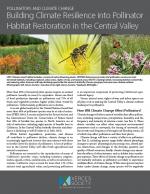As a science-based organization, the Xerces Society produces dozens of publications annually, all of which employ the best available research to guide effective conservation efforts. Our publications range from guidelines for land managers, to brochures offering overviews of key concepts related to invertebrate conservation, from books about supporting pollinators in farmland, to region-specific plant lists. We hope that whatever you are seeking—whether it's guidance on making a home or community garden pollinator-friendly, advice on developing a local pesticide reduction strategy, or detailed information on restoring habitat—you will find it here!
Find Publications
Use the search functions to sort by publication type (books, guidelines, fact sheets, etc.), location, and/or subject (agriculture, gardens, pollinators, pesticides, etc.).
Improving pollinator habitat along roadsides and rights-of-way has many benefits, even beyond providing habitat for these important insects—including carbon sequestration and soil stabilization. Although this fact sheet is centered on California, many lessons are more broadly applicable, and can provide a useful jumping-off point for climate-smart habitat planning for other regions.
While habitat degradation, pesticides, and disease all contribute to pollinator decline, climate change is an increasingly significant stressor that may interact with these to further drive the decline of pollinators. A loss of pollinators in the Central Valley will affect both agricultural and natural ecosystems. Farms, natural areas, rights-of-way, and urban spaces can all play a role in making the Central Valley a climate-resilient landscape for pollinators.
A Native Seed Industry Guide
Increasing the availability of milkweeds is critical to monarch conservation, but seed production can be difficult. While monarchs are the most well-known milkweed specialists, other specialist milkweed-feeding insects can cause damage to valuable milkweed crops. Our guide provides management strategies for dealing with common milkweed pests including aphids, milkweed bugs, and milkweed beetles.
Most of North America’s native bee species only forage over a distance of a few hundred yards, so with a little planning, your yard can provide a safe space for bees and other pollinators to thrive.
Maintaining Healthy Aquatic Ecosystems
California’s waters are at risk from current uses of neonicotinoid insecticides. This fact sheet summarizes Xerces’ findings from our report, Neonicotinoids in California’s Surface Waters. It examines the risks to rivers and streams, as well as other ecosystems, and recommends that regulators take action now to address the issue in the state.
This fact sheet delves into how these impacts on pollinators occur, and offers mitigation measures and alternative pest management strategies.
Guidelines for Providing Native Bee Habitat on Farms
Farming for Bees outlines ways to protect and enhance habitat for native crop pollinators in the farm landscape. Containing a wealth of information about common groups of native bees, their habitat requirements, and conservation strategies to increase their numbers on farms.
This 16-page bulletin will help you use cover crops to encourage populations of pollinators and beneficial insects on your farm while you address your other resource concerns. It begins with a broad overview of pollinator and beneficial insect ecology, then describes cover crop selection and management, how to make cover crops work on your farm, and helpful and proven crop rotations. It will also touch on the limitations of cover crops and pesticide harm reduction, among other topics.
Guidelines for Conservation Biological Control
This publication outlines the ecology of many native beneficial insect groups and highlights recommended strategies for conservation biological control. While native predator and parasitoid insects alone may not solve all of a producer’s pest problems, they can be an important part of an Integrated Pest Management system and contribute to reduced need for pesticides over time.





